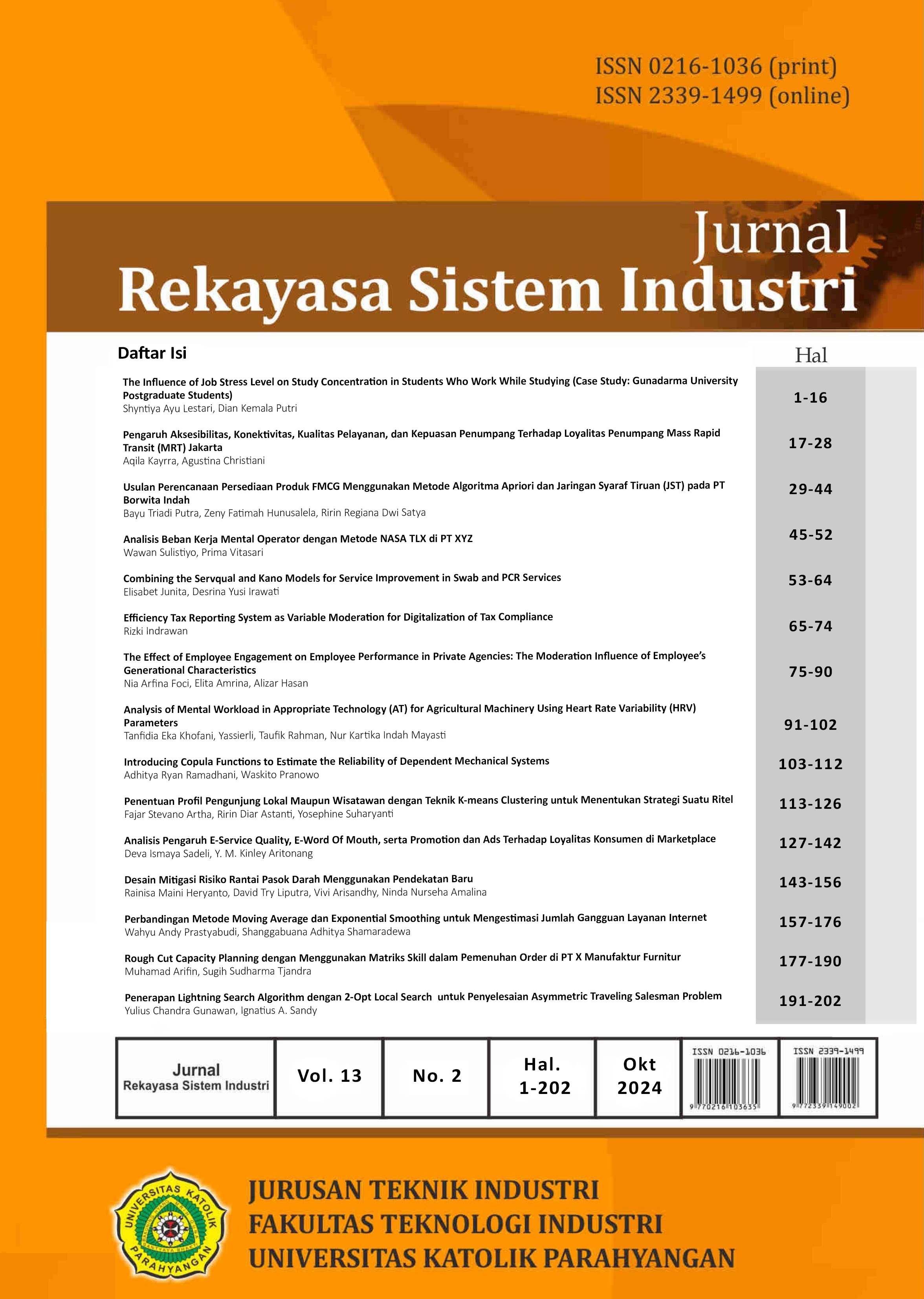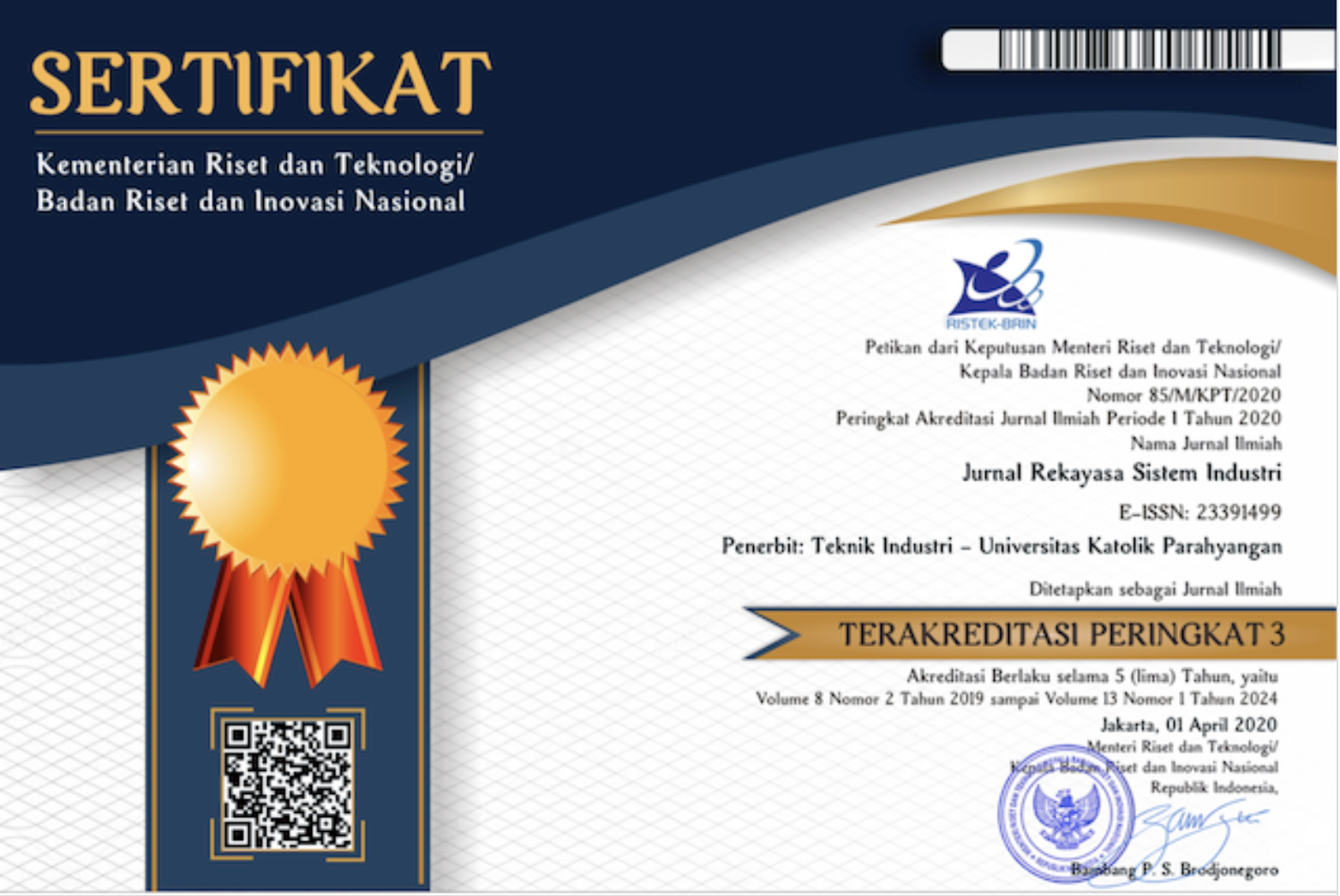Penentuan Profil Pengunjung Lokal Maupun Wisatawan dengan Teknik K-means Clustering untuk Menentukan Strategi Suatu Ritel
DOI:
https://doi.org/10.26593/jrsi.v13i2.7270.113-126Abstrak
Sektor pariwisata tidak dapat dipungkiri memberikan dampak ekonomi yang besar bagi suatu wilayah. Salah satu aktivitas para wisatawan adalah berbelanja, sehingga kehadiran wisatawan dapat menimbulkan pangsa pasar tambahan pada suatu ritel. Oleh karena itu peritel perlu menangkap peluang ini dengan melakukan strategi yang sesuai dengan profil pengunjungnya baik itu pengunjung lokal maupun wisatawan. Penelitian pada artikel ini mengusulkan strategi suatu ritel dengan melakukan analisis profil pengunjung lokal maupun wisatawan, dimana data transaksi dari Point of Sales (POS) diambil untuk mengklasifikasikan pengunjung berdasarkan jarak domisili dengan peritel. Selanjutnya dilakukan uji hipotesis untuk memahami perbedaan pola pembelian antara pengunjung lokal dan wisatawan dan juga teknik K-means clustering untuk membagi pengunjung menjadi kelompok-kelompok berdasarkan jarak, usia, dan nilai pembelian. Interpretasi hasil clustering membantu mengidentifikasi pola pembelian pada masing-masing kelompok, sehingga peritel dapat menyesuaikan strategi pemasaran dan promosi sesuai dengan profil pelanggan Melalui analisis clustering dari contoh studi kasus di salah satu peritel yang ada di Yogyakarta, Indonesia, ditemukan 3 kelompok utama pelanggan: tidak aktif, aktif, dan pelanggan dari luar pulau. Prioritas peritel adalah memfokuskan upaya pada kelompok aktif, terutama kluster 4, dengan member aktif dan nilai transaksi tinggi. Kluster 6 dan 9 juga perlu menjadi target untuk meningkatkan probabilitas menjadi kluster 4. Kluster 1 dapat diabaikan dalam upaya pemasaran. Ritel harus menyesuaikan strategi untuk kluster 3 berdasarkan waktu kunjungan mereka.
Referensi
Albayrak, T., Caber, M., & Çömen, N. (2016). Tourist shopping : The relationships among shopping attributes , shopping value , and behavioral intention. TMP, 18, 98–106. https://doi.org/10.1016/j.tmp.2016.01.007
Badan Pusat Statistik Provinsi DI Yogyakarta. (2021). Provinsi DI Yogyakarta Dalam Angka 2021. 1102001.34.
Bouncken, R. B., Kraus, S., & Roig-Tierno, N. (2021). Knowledge- and innovation-based business models for future growth: digitalized business models and portfolio considerations. Review of Managerial Science, 15(1), 1–14. https://doi.org/10.1007/s11846-019-00366-z
Casais, B. (2023). Motivations for Tourism Shopping in Department Stores : An Exploratory Research about Tourists ’ Profiles Visiting El Corte Inglés Gaia. December 2019. https://doi.org/10.2478/ejthr-2019-0003
Chang, Y. W., & Polonsky, M. J. (2012). The influence of multiple types of service convenience on behavioral intentions: The mediating role of consumer satisfaction in a Taiwanese leisure setting. International Journal of Hospitality Management, 31(1), 107–118. https://doi.org/10.1016/j.ijhm.2011.05.003
Chang, Y. Y., Hughes, P., Hodgkinson, I., Chang, C. Y., & Seih, Y. T. (2022). The antecedents of corporate entrepreneurship: multilevel, multisource evidence. In Review of Managerial Science (Vol. 16, Issue 2). Springer Berlin Heidelberg. https://doi.org/10.1007/s11846-021-00447-y
Choi, M. J., Heo, C. Y., & Law, R. (2016). Developing a Typology of Chinese Shopping Tourists: An Application of the Schwartz Model of Universal Human Values. Journal of Travel and Tourism Marketing, 33(2), 141–161. https://doi.org/10.1080/10548408.2014.997961
Dallen, B., Channel, T., & Chesworth, N. E. (2006). Shopping Tourism , Retailing , and Leisure. September 2005, 280–282. https://doi.org/10.1016/j.annals.2005.10.001
Dudding, V., & Ryan, C. (2000). The impacts of tourism on a rural retail sector: A New Zealand case study. Tourism Economics, 6(4), 301–319. https://doi.org/10.5367/000000000101297659
Epstein, L. D., Inostroza-Quezada, I. E., Goodstein, R. C., & Choi, S. C. (2021). Dynamic effects of store promotions on purchase conversion: Expanding technology applications with innovative analytics. Journal of Business Research, 128, 279–289. https://doi.org/10.1016/j.jbusres.2021.02.032
Febrianty, D., Wardani, N., Setiawan, B., & Riana, F. D. (2021). THE INFLUENCE OF STORE ATMOSPHERE ON REVISIT INTENTION AT SHOPPING TOURISM. 21(4), 301–310.
Goutte, C., & Zhu, X. (Eds.). (2020). Advances in Artificial Intelligence (Vol. 12109). Springer International Publishing. https://doi.org/10.1007/978-3-030-47358-7
Guan, J., Ma, E., & Bi, J. (2023). Impulsive Shopping Overseas: Do Sunk Cost, Information Confusion, and Anticipated Regret Have a Say? Journal of Hospitality and Tourism Research, 47(3), 549–573. https://doi.org/10.1177/10963480211024450
Guney, S., Peker, S., & Turhan, C. (2020). A combined approach for customer profiling in video on demand services using clustering and association rule mining. IEEE Access, 8, 84326–84335. https://doi.org/10.1109/ACCESS.2020.2992064
Henderson, J. C., Chee, L., Mun, C. N., & Lee, C. (2011). Shopping, tourism and retailing in Singapore. Managing Leisure, 16(1), 36–48. https://doi.org/10.1080/13606719.2011.532599
Hughes, A. (1994). Strategic Database Marketing: The Masterplan for Starting and Managing a Profitable, Customer-Based Marketing Program. Irwin Professional Publishing.
Hurst, J. L., Niehm, L. S., Hurst, J. L., & Niehm, L. S. (2014). Tourism shopping in rural markets : a case study in rural Iowa. https://doi.org/10.1108/17506181211246357
Jin, H., Moscardo, G., & Murphy, L. (2017). Making sense of tourist shopping research: A critical review. Tourism Management, 62, 120–134. https://doi.org/10.1016/j.tourman.2017.03.027
Khouja, M., Subramaniam, C., & Vasudev, V. (2020). A comparative analysis of marketing promotions and implications for data analytics. International Journal of Research in Marketing, 37(1), 151–174. https://doi.org/10.1016/j.ijresmar.2019.07.002
Kong, W. H., & Chang, T. Z. (Donald). (2016). Souvenir Shopping, Tourist Motivation, and Travel Experience. Journal of Quality Assurance in Hospitality and Tourism, 17(2), 163–177. https://doi.org/10.1080/1528008X.2015.1115242
Kraus, S., Rigtering, J. P. C., Hughes, M., & Hosman, V. (2012). Entrepreneurial orientation and the business performance of SMEs: A quantitative study from the Netherlands. Review of Managerial Science, 6(2), 161–182. https://doi.org/10.1007/s11846-011-0062-9
Kumar, D., Trivedi, M., & Grewal, D. (2008). Understanding the Determinants of Retail Strategy : An Empirical Analysis ଝ. 84, 256–267. https://doi.org/10.1016/j.jretai.2008.06.004
Lehto, X. Y., Chen, S. Y., & Silkes, C. (2014). Tourist shopping style preferences. https://doi.org/10.1177/1356766713484727
Leković, S. (2016). The Role of Retail Strategy in the Development and Efficiency of Business on the Global Electronic Market. 21(4), 22–28.
Li, L. H., Cheung, K. S., & Han, S. Y. (2018). The impacts of cross-border tourists on local retail property market: an empirical analysis of Hong Kong. Journal of Property Research, 35(3), 252–270. https://doi.org/10.1080/09599916.2018.1511628
Lloyd, A. E., Yip, L. S. C., & Luk, S. T. K. (2011). An examination of the differences in retail service evaluation between domestic and tourist shoppers in Hong Kong. Tourism Management, 32(3), 520–533. https://doi.org/10.1016/j.tourman.2010.04.004
Makkonen, T. (2016). Cross-border shopping and tourism destination marketing: the case of Southern Jutland, Denmark. Scandinavian Journal of Hospitality and Tourism, 16(November), 36–50. https://doi.org/10.1080/15022250.2016.1244506
McDowell, W. C., Peake, W. O., Coder, L. A., & Harris, M. L. (2018). Building small firm performance through intellectual capital development: Exploring innovation as the “black box.” Journal of Business Research, 88(June 2017), 321–327. https://doi.org/10.1016/j.jbusres.2018.01.025
McDowell, W. C., Wilson, R. C., & Kile, C. O. (2016). An examination of retail website design and conversion rate. Journal of Business Research, 69(11), 4837–4842. https://doi.org/10.1016/j.jbusres.2016.04.040
Mehta, S., Jain, A., & Jawale, R. (2014). Impact of Tourism on Retail Shopping in Dubai. 5(6), 530–535. https://doi.org/10.7763/IJTEF.2014.V5.428
Moodley, R., Chiclana, F., Caraffini, F., & Carter, J. (2020). A product-centric data mining algorithm for targeted promotions. Journal of Retailing and Consumer Services, 54. https://doi.org/10.1016/j.jretconser.2019.101940
Moscardo, G. (2005). destination choice and experience tourists ’ destination choice and experience. https://doi.org/10.1177/135676670401000402
Muro-rodríguez, A. I., Pérez-jiménez, I. R., & Sánchez-araque, J. A. (2020). Impact of Shopping Tourism for the Retail Trade as a Strategy for the Local Development of Cities. 11(January), 1–5. https://doi.org/10.3389/fpsyg.2020.00067
Pantano, E., & Dennis, C. (2019). Journal of Retailing and Consumer Services Store buildings as tourist attractions : Mining retail meaning of store building pictures through a machine learning approach. Journal of Retailing and Consumer Services, 51(January), 304–310. https://doi.org/10.1016/j.jretconser.2019.06.018
Parlett, G., Fletcher, J., & Cooper, C. (1995). The impact of tourism on the Old Town of Edinburgh. Tourism Management, 16(5), 355–360. https://doi.org/10.1016/0261-5177(95)00038-P
Phumchusri, N., Kosawanitchakarn, W., Chawanapranee, S., & Srimook, S. (2022). Evaluating promotional pricing effectiveness using convenience store daily sales data. Journal of Revenue and Pricing Management. https://doi.org/10.1057/s41272-022-00415-5
Rooderkerk, R. P., DeHoratius, N., & Musalem, A. (2022). The past, present, and future of retail analytics: Insights from a survey of academic research and interviews with practitioners. Production and Operations Management, 31(10), 3727–3748. https://doi.org/10.1111/poms.13811
Sen, S. S., Alexandrov, A., Jha, S., McDowell, W. C., & Babakus, E. (2023). Convenient = competitive? How Brick-And-Mortar Retailers can cope with Online Competition. Review of Managerial Science, 17(5), 1615–1643. https://doi.org/10.1007/s11846-022-00566-0
Shen, B. (2021). E-commerce Customer Segmentation via Unsupervised Machine Learning. ACM International Conference Proceeding Series, PartF168982. https://doi.org/10.1145/3448734.3450775
Song, Y., Escobar, O., Arzubiaga, U., & De Massis, A. (2022). The digital transformation of a traditional market into an entrepreneurial ecosystem. Review of Managerial Science, 16(1), 65–88. https://doi.org/10.1007/s11846-020-00438-5
Swanson, K. K., & Horridge, P. E. (2006). Travel motivations as souvenir purchase indicators. Tourism Management, 27(4), 671–683. https://doi.org/10.1016/j.tourman.2005.03.001
Turley, L. W., & Chebat, J. (2010). Linking Retail Strategy , Atmospheric Design and Shopping Behaviour. November 2014, 37–41. https://doi.org/10.1362/0267257022775891
Weyer, J., Tiberius, V., Bican, P., & Kraus, S. (2021). Digitizing Grocery Retailing: The Role of Emerging Technologies in the Value Chain. International Journal of Innovation and Technology Management, 17, 1–5. https://doi.org/https://doi.org/10.1142/S0219877020500583
Yiu, C. Y. (2023). The Impacts of Shopping Tourism on Retail Sales and Rents : Lessons from the COVID-19 Quasi-Experiment of Hong Kong.
Yoseph, F., Ahamed Hassain Malim, N. H., Heikkilä, M., Brezulianu, A., Geman, O., & Paskhal Rostam, N. A. (2020). The impact of big data market segmentation using data mining and clustering techniques. Journal of Intelligent and Fuzzy Systems, 38(5), 6159–6173. https://doi.org/10.3233/JIFS-179698
Yu, H. (2017). No Title. Why the Macy’s Death Spiral Isn’t the End of Retail. https://fortune.com/2017/01/11/macys-death-retail-department-stores/
Yu, H., & Littrell, M. A. (2003). Journal of Travel Research. https://doi.org/10.1177/0047287503257493
Yuksel, A. (2004). Shopping experience evaluation: A case of domestic and international visitors. Tourism Management, 25(6), 751–759. https://doi.org/10.1016/j.tourman.2003.09.012













